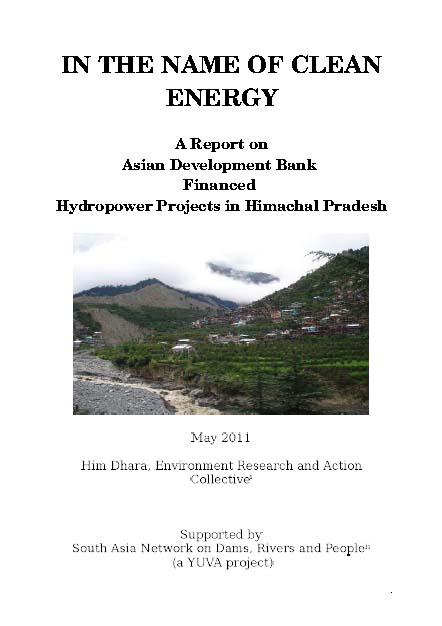 This report by Him Dhara, an environmental research and action collective, deals with the Asian Development Bank financed hydropower projects in Himachal Pradesh, which are leading to obstruction of the rivers and their consequent disappearance for harnessing energy and making ‘judicious’ use of the water. Within the hydro sector the attention has turned to the Indian Himalayan region which is estimated to have seventy nine per cent of the total hydropower potential of the country.
This report by Him Dhara, an environmental research and action collective, deals with the Asian Development Bank financed hydropower projects in Himachal Pradesh, which are leading to obstruction of the rivers and their consequent disappearance for harnessing energy and making ‘judicious’ use of the water. Within the hydro sector the attention has turned to the Indian Himalayan region which is estimated to have seventy nine per cent of the total hydropower potential of the country.
The technology of ‘run of the river’ (ROR) used to tap “the flow of rivers” in high gradient zones to generate power has given impetus to setting up of hydro-projects in the Himalayan states. In India, the mountainous region of the Himalayas offered the “perfect setting” for such projects, with the availability of several flowing water sources that could be tapped before they reached the plains. Of the Himalayan states, after Arunachal Pradesh, Himachal Pradesh is second in line with a hydropower potential of about 21000 MW. The installed capacity has increased twenty fold (from 326 MW to 6370 MW) in the last ten years indicating the frenzied pace of hydropower development in the state.
During the early part of the decade, the ‘climate change’ crisis registered in the mainstream psyche and the catch phrase of ‘green technology’ gave additional impetus to renewable energy sources like hydropower over coal or nuclear power. The Himachal Pradesh (HP) government and its main power developing corporations have gone all out to sell hydropower as “clean, efficient and environment friendly”. In its pursuit of a “cleaner environment”, the HP government prepared a draft Climate Change Policy in 2008 to facilitate the implementation of the Clean Development Mechanism for companies building hydro-power projects in the state.
ADB, a major player in the hydro-power sector in HP, in its project documents and policies has consistently insisted on safeguard mitigation measures on three fronts – social, environmental and public or ‘stakeholder consultation’. This study attempts to look at the implications of these on the Himachal Clean Energy Development Programme. It is with the above objectives and framework that this report, attempts to present a critical analysis of ADB’s investment in the hydropower sector in the state, putting together field observations, based on discussions with project affected communities along with compliance or violations of norms and legislations that protect the livelihood interests and environmental rights of project affected communities.
The study has the following general recommendations -
- A complete moratorium on all hydro-projects that are under planning and under construction until an independent review is carried out on impacts as well as performance of existing hydro-projects in the state.
- Any such review should be done by a credible multi-disciplinary independent committee which apart from experts from the social, environmental and technical fields should include activists, representatives of NGOs as well as local communities.
- All projects in eco-sensitive zones and alpine areas like Kinnaur, Ladakh, Chamba and Kullu should be immediately scraped.
- All projects in river valleys where a large number of projects are already under construction or operation should be immediately reviewed.
- All sites where local communities are resisting the setting up of projects should be reviewed with free and fair public consultations.
- Free prior informed consent from local affected people and gram sabhas must be mandatory in any state policy for the commissioning of any hydro-project.
- In the existing and operational projects, committees for grievance redressal and implementation of mitigation should have full participation and representation of local affected people.
- Compliance to the Forest Rights Act 2006, PESA 1996 and HP Land Transfer rules needs to be ensured.
- In projects under construction, regular and strict compliance monitoring needs to be carried out of the forest and environment clearance conditions and these reports should be shared with the local people.
Download the report here -